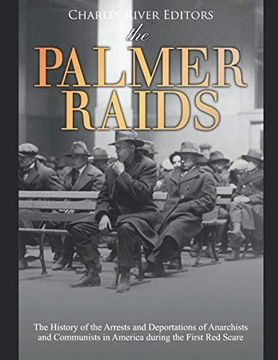The Palmer Raids: The History of the Arrests and Deportations of Anarchists and Communists in America During the First red Scare (in English)
Synopsis "The Palmer Raids: The History of the Arrests and Deportations of Anarchists and Communists in America During the First red Scare (in English)"
*Includes pictures*Includes excerpts of contemporary accounts*Includes a bibliography for further reading"The war power is of necessity an inherent power in every sovereign nation. It is the power of self-reservation and that power has no limits other than the extent of the emergency." – Attorney General A. Mitchell Palmer, December 1918While the period from 1945-1955 was the longest and most extensive period of time in American history when a fear of communism gripped the country, it was not the first. World War I was the first major foreign conflict the U.S. was involved in, after being safe behind the Atlantic Ocean, and Americans were now afraid of espionage and sabotage. As a result, people of German descent came under suspicion, and this subjected innocent German-Americans to mob violence, much of it perpetrated by a vigilante group called the American Protective League (APL), which had a quarter of a million members dedicated to rooting out German spies. When they did not find enough, they turned their sights on homegrown subversives, namely the International Workers of the World, the “Wobblies.”With the end of the war, concern over German subversives was replaced with concerns over communist subversives. By 1919, the Bolshevik Revolution had spread throughout Central Europe and seemed to threaten the rest of the world. In America, newspaper stories openly worried about a similar revolution in the country. A rash of strikes fed fears that class warfare, fomented by foreign communist forces, would break out at any moment.In this powder keg, all that was needed was a spark to create full-blown hysteria, and the spark came on June 2, 1919, when the home of Attorney General A. Mitchell Palmer was bombed, injuring Palmer and killing the bomber. The anarchist leaflets he was carrying were scattered in the bomb debris, and this attack on his home prompted Palmer, who had been a reformist Quaker, to launch an all-out war against left-wing radicals. In the process, the Attorney General, who had already been impressed with a self-confident and energetic young man named J. Edgar Hoover, put him in charge of the battle against radicalism. The Red Scare had begun in earnest.Palmer decided that the way to eliminate the radical threat in America was to get rid of the radicals by deporting them en masse out of the country. There were just two problems with Palmer’s solution: most “radicals” were American citizens and not aliens, and the Justice Department had no authority to deport aliens for radical activities. Undeterred, Palmer set up the General Intelligence Division (GID) under Hoover, who set about collecting and organizing information (both factual and unsubstantiated rumors) about radical organizations and individuals that came in from state, local, and federal agencies. One of the first things Hoover did, drawing on his library experience, was to set up a card index listing every radical individual and organization in the country. In short order, the number of cards had grown to 450,000.The raids succeeded in rounding up 10,000 people, many at meetings open to the general public. The problems inherent in this approach were apparent several days later when almost 5,000 had to be released because they were either not Communist Party members or because they were otherwise law-abiding citizens. Those who remained in custody were questioned using “third degree” tactics of intimidation and forced to sign statements regardless of their accuracy. While the investigators were obtaining the evidence necessary to deport dangerous radicals, Hoover initiated a carefully orchestrated publicity campaign designed to inflame fears of the radicals among the American public. This was the first time Hoover engaged in such activities, and from it he learned the value of public opinion in law enforcement. It was a lesson he would carry with him when he became Director of the FBI.

